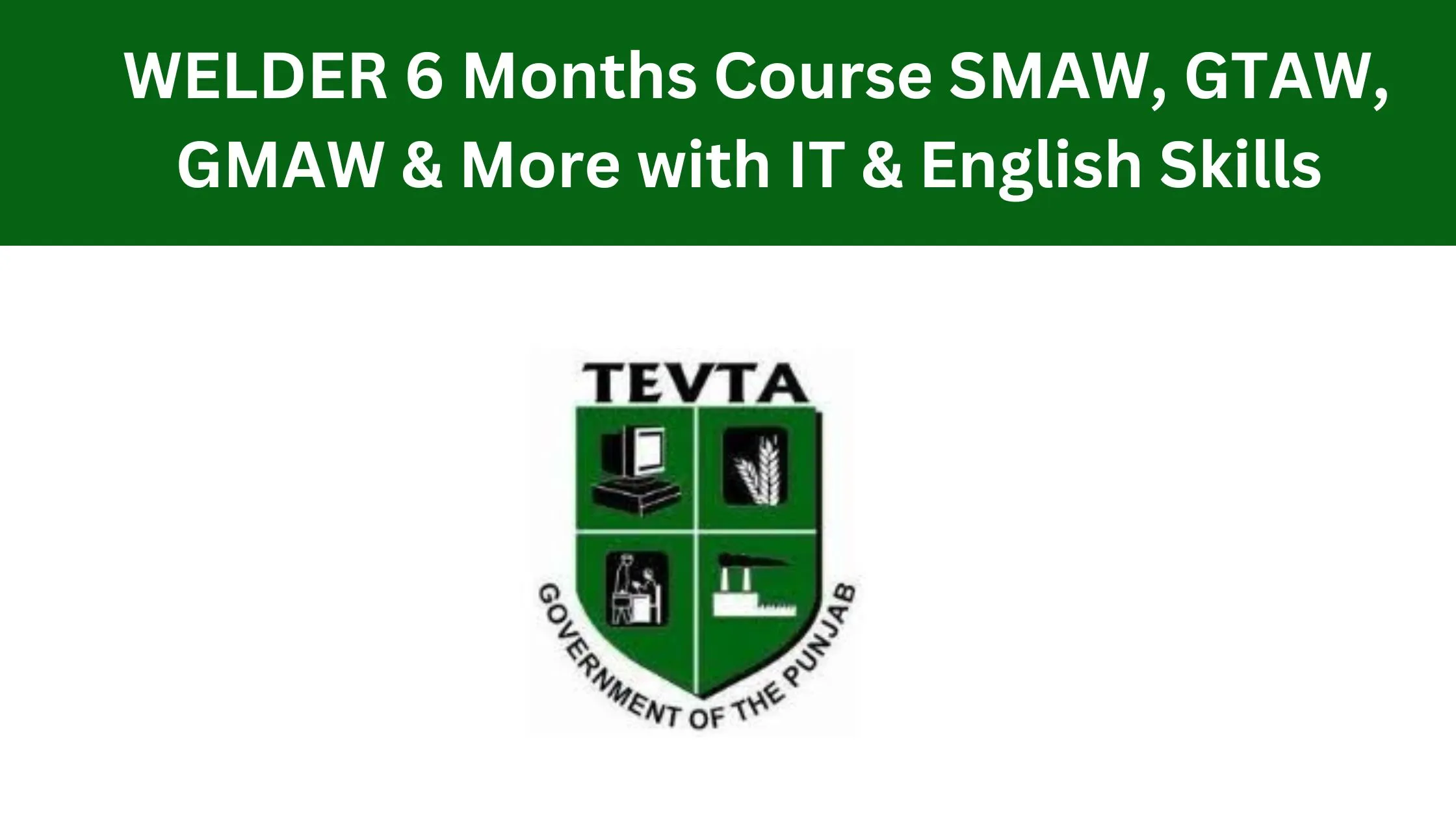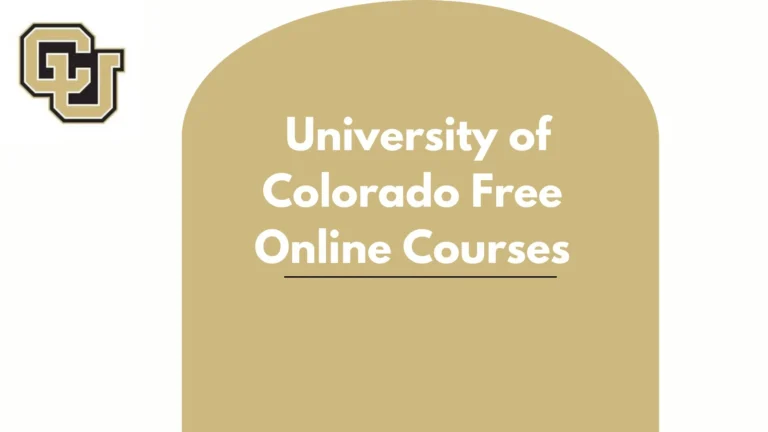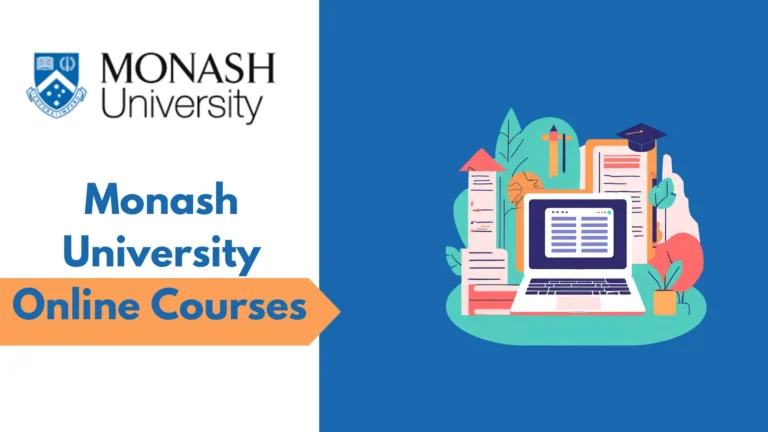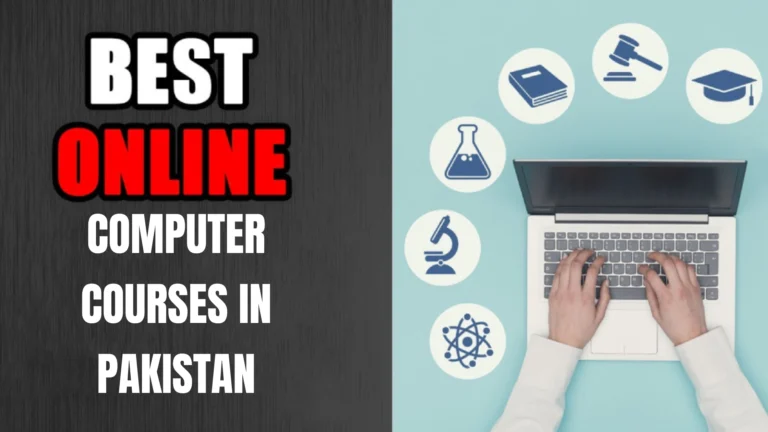WELDER 6 Months Course SMAW, GTAW, GMAW & More with IT & English Skills
WELDER 6 Months Course is offered by tevta courses you can avail this opportunity in 2025. The construction industry is expanding day by day due to enhanced development in industrial commercial and real estate enterprises. As a result of this fact, the job demand for trained labor and field staff has increased.
This curriculum has been developed keeping in view the requirements of the construction industry by focusing more on practical knowledge along with necessary theoretical knowledge and work ethics.
This curriculum covers major topics such as basic metal work, measuring tools, Shielded Metal Arc Welding (SMAW), Gas Tungsten Arc Welding (GTAW), Gas Metal Arc Welding (GMAW), Gas Welding/Cutting, welding positions for plate & pipe welding, construction fabrication, along with functional English and information technology.
Also see: Manual Jewelry Designing Course (07-Weeks)
Details About WELDER 6 Months Course SMAW, GTAW, GMAW & More with IT & English Skills
- Name of the Course: Welder (SMWA GTAW GMAW Gas Welding & Gas Cutting)
- Entry Level: Middle (preferable) Matric
- Duration of Course: 6 – Months (800 Contact Hours)
- Practical: 90%
- Theory: 10%
- Medium of Instruction: Urdu / English
SKILL COMPETENCY DETAILS
Upon successful completion of this WELDER 6 Months Course 2025, the trainee should be able to:
- Apply all safety precautions regarding tools, equipment & each welding process.
- Make a bevel of the plate/pipe to make it ready for welding.
- Apply shielded metal arc welding by selecting electrodes.
- Apply gas tungsten arc welding by selecting tungsten electrodes.
- Apply gas metal arc welding by selecting filler wires.
- Apply arc welding by selecting current settings.
- Prepare different welding positions both for plate & pipe welding.
- Identify different welding defects, their causes, effects, and remedies.
- Apply gas welding/gas cutting.
- Perform welding on various parts/jobs as per design and drawing.
- Undertake projects of construction fabrication as per drawing & design.
Also see: Gemstone Identification Course: 5-Week Practical Training for Beginners and Traders
KNOWLEDGE PROFICIENCY DETAILS
Upon successful completion of this WELDER 6 Months Course, the trainee should be able to:
- Explain measuring tools.
- Explain marking tools.
- Define drilling and cutting tools.
- Explain the safe usage of tools.
- Explain shielded metal arc welding by selecting electrodes & current settings.
- Explain tungsten inert gas welding and its shielding gas.
- Explain gas metal arc welding and its shielding gas.
- Explain gas welding/cutting.
- Explain construction fabrication for the construction industry.
- Explain construction fabrication drawings.
- Explain different welding positions for plate & pipe welding.
SCHEME OF STUDIES
Welder (6-Months Course)
| S.No | Main Topics | Theory Hours | Practical Hours | Total Hours |
|---|---|---|---|---|
| 1 | Awareness about Safety | 12 | 0 | 12 |
| 2 | Introduction of Tools & Basic Metal Work | 18 | 10 | 28 |
| 3 | Gas Welding and Gas Cutting | 4 | 0 | 4 |
| 4 | Shielded Metal Arc Welding (SMAW) | 16 | 0 | 16 |
| 5 | Gas Tungsten Arc Welding (GTAW) | 4 | 0 | 4 |
| 6 | Gas Metal Arc Welding (GMAW) | 4 | 0 | 4 |
| 7 | Common Welding Abbreviations & Terminologies | 2 | 0 | 2 |
| 8 | Basic Information of Mathematics | 10 | 0 | 10 |
| 9 | Basic Knowledge of Engineering Drawing | 10 | 0 | 10 |
| 10 | SMAW-JOINTS | 0 | 300 | 300 |
| 11 | Gas Tungsten Arc Welding (GTAW) JOINTS | 0 | 120 | 120 |
| 12 | MIG-JOINTS | 0 | 100 | 100 |
| 13 | Gas Welding & Gas Cutting Practice | 0 | 70 | 70 |
| 14 | I.T Fundamentals | 8 | 32 | 40 |
| 15 | Functional English | 16 | 64 | 80 |
DETAIL OF COURSE CONTENTS
Welder (6 Months Course)
- Awareness about Safety Module-1
- Personal Protective Equipment (PPE): Welding helmet, face shield, gloves/apron/cap, steel-capped safety shoes, goggles, ear protectors, safety belt, etc.
- Prepare workplace: Housekeeping and workplace preparation, safe working environment, effects on performance.
- Use of Extinguishers: Causes of fire, fire hazards, types of extinguishers, fire blankets, water/sand buckets, etc.
- Placing and caring of cylinders: Awareness about mishandling, cylinder transportation, placement, proper ventilation system.
- Introduction of Tools & Basic Metal Work Module-2
- Measuring Tools: Steel foot rules, steel T-square, Vernier height gauge, V-block, calipers, micrometers.
- Marking Tools: Steel scribers, dividers, center punch, surface gauge.
- Cutting Tools: Shears, hand hacksaw, chisels, drills/countersinks, thread cutting taps & dies.
- Filing Practice: Filing procedure, types of files, grinder usage, etc.
- Basic Metal Work: Organizing the workbench, tool selection, cutting, filing, squaring, drilling, threading, etc.
- Gas Welding and Gas Cutting Module-3
- Gas Welding/Cutting: Gas cylinders, pressure regulators, welding torches, operating instructions, cutting procedure, safety rules, and welding techniques.
- SMAW Shielded Metal Arc Welding/ MMA Module-4
- Basic Electricity Terminology: Conductors, circuits, current, voltage, resistance, watt.
- Welding Machines: Transformer, generator/DC motor, rectifier.
- Arc Welding Process & Accessories: Electrodes, polarity, welding positions for plates and pipes, welding defects.
- Gas Tungsten Arc Welding (GTAW) / Tungsten Inert Gas (TIG) Module-5
- Principles, Equipment & Techniques: Shielding gases, electrodes, regulators, welding torch, and machine setup.
Gas Tungsten Arc Welding (GTAW) / Tungsten Inert Gas (TIG) Module-5
- Principles, Equipment & Techniques:
Shielding gases, electrodes, regulators, welding torch, machine setup. - TIG Welding Techniques:
Use of filler material, safety measures, and basic welding techniques.
- Gas Metal Arc Welding (GMAW) / Metal Inert Gas (MIG/MAG) Module-6
- Process & Equipment:
Safety rules, shielding gases, regulators, wire spools, MIG torches, wire feed control, and general operating instructions. - MIG Welding Techniques:
Techniques for applying filler wires, welding preparation, and handling various welding positions.
- Process & Equipment:
- Common Welding Abbreviations & Terminologies Module-7
- Terminologies & Abbreviations:
Definitions of terms like arc, electrode, crater, polarity, root gap, base metal, etc. - Common Abbreviations:
MAG (Metal Active Gas), FCAW (Flux Cored Arc Welding), SMAW (Shielded Metal Arc Welding), PAW (Pressure Arc Welding), WPS (Welding Procedure Specification), etc.
- Terminologies & Abbreviations:
- Basic Information of Mathematics Module-8
- Operations on Numbers:
Addition, subtraction, multiplication, and division of simple and fractional numbers. - Area Calculation:
Methods to calculate areas of different shapes such as squares, rectangles, triangles, and circles. - Unit Conversion:
Conversion of units such as inches to metric and vice versa.
- Operations on Numbers:
- Basic Knowledge of Engineering Drawing Module-9
- Drawing Equipment:
Includes drawing board, T-square, set squares, compass/dividers, pencils (H, HB), erasers, and sharpeners. - Kinds of Drawing Lines:
Types such as outline, dotted line, centerline, section line, dimension line, etc. - Orthographic Drawing:
First and third angle projections.
- Drawing Equipment:
- SMAW Joints
- Practical Focus:
Preparing and performing welding on various joints such as lap joints, corner joints, V-butt joints in multiple positions (flat, horizontal, vertical, overhead), and pipe welding positions (1G, 2G, 5G, 6G).
- Practical Focus:
LIST OF PRACTICALS
- SMAW Joints:
These practicals include tasks such as striking the electrode, restarting the arc, welding in various positions (1G, 2G, 3G, 4G), performing pipe welding, and fabricating frames using angle iron and square pipes. - GTAW Joints:
Practical work includes tasks like striking electrodes, maintaining the arc, welding flat joints, and corner joints, pipe-to-pipe welding, and performing 6G welding on inclined pipes. - MIG Joints:
Practical tasks include blind welding joints, corner joints, lap joints, butt joints, and T/Fillet joints. - Gas Welding Joints & Gas Cutting Practice:
Practicals involve flame making, puddle formation, welding joints (butt, lap, corner), and practicing gas-cutting techniques.
SCHEME OF STUDIES: I.T. Fundamentals
| S.No | Main Topics | Theory Hours | Practical Hours | Total Hours |
|---|---|---|---|---|
| 1 | Introduction to Computers | 2 | 6 | 8 |
| 2 | Typing – Microsoft Word | 4 | 14 | 18 |
| 3 | Internet & Electronic Mail | 2 | 12 | 14 |
DETAIL OF COURSE CONTENTS: I.T. Fundamentals
- Introduction to Computers:
Topics include computer definition, hardware, input/output units, system and application software, basic Windows operations, desktop customization, and file/folder management. - Typing & Word Processing (MS Word):
Focuses on typing skills, document formatting, saving and retrieving files, and printing documents. - Emailing & Internet Surfing:
Includes lessons on internet connectivity, email usage, web searching, creating email accounts, sending/receiving attachments, etc.
LIST OF PRACTICALS: I.T. Fundamentals
- Turning on/off and setting up power supply.
- Accessing and using the desktop, icons, and shortcuts.
- Viewing directories, customizing folders, copying, deleting, and moving files.
- Opening MS Word, learning typing lessons (e.g., A S D F, J K L ;, etc.).
- Formatting documents, page setup, and using the internet.
- Sending and receiving emails, downloading, and uploading attachments.
SCHEME OF STUDIES: Functional English
| S.No | Main Topics | Theory Hours | Practical Hours | Total Hours |
|---|---|---|---|---|
| 1 | Use of past indefinite tense | 2 | 6 | 8 |
| 2 | Use of ‘was,’ ‘were,’ questions and negatives | 3 | 6 | 8 |
| 3 | Explaining situations/analysis | 2 | 6 | 8 |
| 4 | Communication in writing | 2 | 6 | 8 |
| 5 | Comprehension | 1 | 6 | 7 |
| 6 | Application/CV Writing | 1 | 6 | 7 |
| 7 | Dialogues | 1 | 9 | 10 |
| 8 | Understanding vocabulary | 1 | 3 | 4 |
LIST OF PRACTICALS: Functional English
- Group discussions
- Interviews
- Role plays
LIST OF LABS
- Basic Workshop:
A general workshop for basic metalwork and welding. - Welding Workshop:
A specialized workshop dedicated to welding practices. - Computer Lab:
Used for I.T. Fundamentals, equipped with desktop computers, printers, internet connection, and multimedia projectors.
LIST OF TOOLS / EQUIPMENT (For a class of 25 students)
- Welding transformer (50 to 450 Amp) complete with leads holder – 6 Nos.
- Welding rectifier – 6 Nos.
- TIG welding machine with accessories – 2 Nos.
- MIG welding machine with accessories – 2 Nos.
- Welding face shield – 12 Nos.
- Safety helmet – 6 Nos.
- Arc welding table – 12 Nos.
- Chipping hammer – 12 Nos.
- Leather gloves (left & right) – 12 sets
- Argon gas cylinder – 4 Nos.
- CO2 gas cylinder – 2 Nos.
- Hand grinder – 2 Nos.
- Auto bevel cutting machine – 1 No.
- Desktop computers (as per MIS section TEVTA) – 26 (1 per student & 1 for the teacher)
- Air Conditioner 1.5 Ton – 2 Nos.
EMPLOYABILITY OF PASS-OUTS
The pass-outs of this WELDER 6 Months Course may find employment opportunities in the following sectors:
- Construction industry
- Automobile industry
- Repair workshops
- Heavy Mechanical Complex, Taxila
- PECO, Kot Lakhpat
- DESCON Engineering
- Pakistan Railways Workshops
- Teaching roles
- Self-employment opportunities
REFERENCE BOOKS
- Health & Safety in Welding (Published by the Department of Labor Wellington, New Zealand)
- Welding Procedures and Applications by A. Banerjee
- Principles of Welding Technology by L.M. Groud
- Welding Engineering by Boniface Rossi
- Workshop Practice-II by Muhammad Ghayas & Muhammad Kamran
- Engineering Drawing by N.D. Bhutt
- High School English Grammar by Wren & Martin
- Oxford English Grammar
- Introduction to Computers by Peter Norton
- Microsoft Office System Step by Step (2007 Edition) by Joyce Cox, Steve Lambert, and Curtis Frye
- Internet and Email with Windows 7 by Studio Visual Steps
MINIMUM QUALIFICATION OF INSTRUCTOR
- Welder:
DAE in ‘Metallurgy & Welding Technology’ with two years of experience in the relevant field.
OR
Two years certificate of Welder (G-II Level) with six years of experience in the relevant field. - Functional English:
M.A. in English. - I.T. Fundamentals:
DAE CIT / BCS from a recognized university.
Contact information
96-H GULBERG-II LAHORE
Ph: 042-99263055-9 99263064







